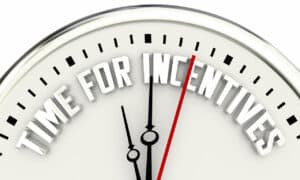In field sales, motivation is essential for success. As a sales leader, keeping your team engaged, driven, and ready to exceed their targets is vital. But how do you inspire that motivation? The answer lies in field sales incentive programs.
When crafted and appropriately implemented, these programs can enhance morale, improve productivity, and drive substantial growth.
But how do you create a successful program? This comprehensive guide will provide you with the essential knowledge of field sales incentive programs and empower you with the tools to design, implement, and evaluate a program that motivates your team and drives your business forward.
Unleashing the Potential of Field Sales Incentive Programs
Field sales incentive programs are strategic frameworks created to reward salespeople who achieve or surpass specific goals in the field. However, these programs go beyond mere bonuses or prizes. These could mold and motivate individuals to become sales professionals who exceed their typical performance standards.
In addition, they assist sales professionals attain elevated positions in their sales achievements. The benefits can be the shape of cash incentives such as bonuses or higher commissions. These individuals can additionally incorporate non-financial incentives like commendations, vouchers, or products.
Executing a sales performance-based initiative is an effective method for sales executives looking to encourage and activate their sales team. This can potentially enhance efficiency, boost team spirit, and encourage employee participation.
Moreover, they coordinate goals in line with wider company objectives, stimulate financial expansion, and boost customer happiness and satisfaction.
Types of Incentive Programs: Finding the Right Fit
When it comes down to inspiring and encouraging your team of sales representatives, you have multiple options for sales commission programs to select.
The secret is choosing the style that corresponds perfectly based on your team’s motivations. Furthermore conforms to your organization’s targets. Here are some common types.
A. Commission-Based Incentives
Commission-based incentives reward salespeople with a percentage of the sales revenue they generate. This kind of incentive scheme is easy. As sales increase a representative’s sales, increased the commission they receive.
For example, when a salesperson sells a $1000 product, having a commission rate of 10%, they make $100 from that sale.
This kind of bonus program provides the greatest benefits for salespeople motivated by financial rewards. These individuals are inspired by the clear connection between their hard work and the money they make.
Pros:
- Directly ties incentives to sales performance.
- Encourages salespeople to close more deals.
- Easy to understand and calculate.
- Provides unlimited earning potential.
- Can be adjusted based on different products or services.
Cons:
- May encourage short-term thinking over long-term customer relationships.
- This can lead to unhealthy competition among salespeople.
B. Performance-Based Incentives
Performance-based incentives reward salespeople for achieving specific performance metrics, such as acquiring new customers, making sales calls, or closing deals.
The programs establish specific goals and incentivize sales representatives whenever they fulfill or outperform the designated goals.
For instance, a sales representative could receive an incentive for every new purchaser they attract. It is possible that they additionally get an extra bonus for each phone conversation with a potential customer they execute higher than a set boundary.
Results-driven incentives are perfect for ambitious sales professionals who excel at achieving and surpassing goals.
Pros:
- Encourages salespeople to meet specific performance metrics.
- Can be tailored to align with company objectives.
- Provides clear targets for salespeople to aim for.
- Can be employed to motivate various behaviors, not limited to sales.
- Can be adapted depending on the team or individual performance.
Cons:
- Could result in prioritizing amount rather than quality.
- Can be demotivating if targets are perceived as unattainable.
C. Team-Based Incentives
Team-based incentives compensate sales reps for achieving team goals, such as total sales revenue or acquiring new customers as a team. These programs promote teamwork and a sense of shared responsibility among team members.
For instance, if a sales team surpasses their quarterly sales target together, they may all be recognized with a bonus or other incentives.
Team-based incentives work well for sales teams that collaborate to reach common objectives and are motivated by collective success.
Pros:
- Encourages teamwork and collaboration.
- Aligns individual efforts with team and company goals.
- Can encourage a positive and supportive team environment.
- Can help to balance out individual performance variations.
- Can be used to incentivize a variety of team behaviors.
Cons:
- High performers may feel penalized if their bonuses are tied to the performance of others.
- Can be difficult to implement fairly in large or diverse teams.
D. Non-Monetary Incentives
Non-monetary incentives offer rewards other than money, such as recognition, gift cards, or merchandise. These programs tap into intrinsic motivations and can be highly effective for salespeople who value recognition and non-financial incentives.
For instance, a salesperson might receive a gift card to a popular restaurant for consistently providing excellent customer service.
Non-monetary incentives are ideal for salespeople who value recognition and non-financial rewards.
Pros:
- Can be highly motivating for salespeople who value recognition.
- Can motivate various behaviors, not just sales.
- Can be customized to individual preferences.
- Can promote a positive and supportive team environment.
- Can be budget-friendly, especially for small businesses.
Cons:
- May not be as motivating for financially driven salespeople.
- Can be difficult to implement fairly and consistently.
E. Tiered Incentives
Tiered incentive programs provide different rewards based on performance. For example, reaching 75% of the target earns a smaller reward, while achieving 100% results in a larger reward. This motivates salespeople to aim for higher levels of performance.
For instance, a salesperson may receive a $100 bonus for reaching 75% of the target, $200 for achieving 100%, and $300 for exceeding the target.
Tiered incentives benefit salespeople who are motivated by earning bigger rewards as they achieve higher levels of performance.
Pros:
- Encourages salespeople to strive for higher performance levels.
- Provides incremental rewards that recognize varying levels of achievement.
- Can be tailored to individual performance levels.
- Can motivate various behaviors, not just sales.
- Can be customized based on individual or team performance.
Cons:
- May lead to a focus on quantity over quality.
- Can be demotivating if targets are perceived as unattainable.
F. Contest-Based Incentives
Contest-based incentive programs create a competitive environment where salespeople compete for rewards. The individual or team with the highest sales or who reaches a specific target first wins the reward. This program fosters healthy competition and is especially motivating for competitive individuals or teams.
For instance, a company could organize a sales contest where the first salesperson to close 10 deals wins a trip to a popular vacation destination.
Contest-based incentives work well for salespeople who enjoy competition and are driven by the chance to surpass their colleagues.
Pros:
- Fosters healthy competition among salespeople.
- Can be highly motivating for competitive individuals.
- Provides clear and exciting rewards for top performers.
- Can motivate various behaviors beyond sales.
- Can be tailored to individual or team performance.
Cons:
- May prioritize winning the contest over building lasting customer relationships.
- Can be demotivating for less competitive individuals.
G. Milestone-Based Incentives
Milestone-based incentive programs reward salespeople upon reaching specific milestones, such as selling a certain number of units or acquiring a set number of new clients. This type of program is particularly motivating for salespeople who thrive on working towards and accomplishing tangible targets.
For instance, a salesperson might receive a bonus for every 10 new clients they bring in.
Milestone-based incentives are beneficial for salespeople who are motivated by the opportunity to work toward and achieve specific, tangible targets.
Pros:
- Encourages salespeople to work towards specific, tangible targets.
- Provides clear and achievable objectives for salespeople.
- Can motivate different actions, not limited to sales.
- Can be tailored to individual performance levels.
- Can be customized for individuals or teams.
Cons:
- May focus more on quantity than quality.
- Can be demotivating if milestones are perceived as unattainable.
H. Recognition-Based Incentives
Recognition-based incentive programs focus on publicly or privately acknowledging salespeople for their achievements. This could include shout-outs in team meetings, features in company newsletters, or certificates of achievement.
Ideal for salespeople who are motivated by recognition and esteem from their peers and superiors.
For instance, a salesperson may receive public recognition during a company meeting for their outstanding customer service abilities. Recognition-based incentives are valuable for salespeople who are motivated by the acknowledgment and appreciation of their colleagues and supervisors.
Pros:
- Fosters a positive and supportive team culture.
- Can be highly motivating for salespeople who value recognition.
- Can motivate various actions, not limited to sales.
- Can be tailored to individual achievements.
- Can be implemented at little to no cost.
Cons:
- May not be as motivating for financially driven salespeople.
- Can be difficult to implement fairly and consistently.
I. Training-Based Incentives
Training-based incentives reward salespeople with advanced training or professional development opportunities when they achieve specific targets.
This program motivates salespeople who want to develop their skills and grow in their roles. They receive rewards like professional development courses for meeting sales targets consistently. It benefits the company by improving the skills and knowledge of the sales reps.
Training-based incentives are advantageous for salespeople driven by personal growth and the chance to improve their skills and knowledge.
Pros:
- Encourages continuous learning and professional development.
- Can be highly motivating for salespeople who value learning and growth.
- Can be used to incentivize a variety of behaviors, not just sales.
- Can be tailored to individual learning objectives.
- Enhances the skills and knowledge of the sales reps, benefiting the company.
Cons:
- May not motivate salespeople who are not interested in learning or professional growth.
- Can be expensive and time-consuming to implement.
J. Time-Based Incentives
Time-based incentive programs reward salespeople with additional time off, flexible working hours, or the option to work remotely upon achieving certain targets. This motivates salespeople who value work-life balance and flexibility in their work arrangements.
For example, a salesperson can receive an extra day off each month for exceeding their sales target.
Time-based incentives are beneficial for salespeople who value work-life balance and flexibility, as they are motivated by the opportunity to have more time off or flexible working arrangements.
Pros:
- Encourages work-life balance and flexibility.
- Can be highly motivating for salespeople who value time off and flexible work arrangements.
- Can incentivize various behaviors, not only sales.
- Can be customized to individual preferences.
- Can improve job satisfaction and employee retention.
Cons:
- May not be as motivating for salespeople who are financially driven.
- Can be difficult to implement fairly and consistently.

Crafting Effective Field Sales Incentive Programs: A Step-by-Step Guide
Creating an effective field sales incentive program requires careful planning and execution. Here are the essential steps to follow:
1. Set Clear Goals
Start by defining clear, measurable objectives that align with your overall business objectives. Set clear, achievable targets with deadlines.
For instance, if your business aims to increase sales by 10% in the next quarter, you can set a specific aim for your field sales reps to achieve a 15% sales increase during the same period.
2. Choose Suitable Rewards
Next, select rewards that will genuinely motivate your field sales reps to achieve their objectives. These rewards can range from cash bonuses and gift cards to extra vacation days and recognition. It’s crucial to pick rewards that hold significance and resonate with your team.
For example, if your team values recognition, you can offer public acknowledgements or personalized trophies. Conversely, if financial incentives drive your team, consider providing cash bonuses or commission increases.
3. Monitor and Adjust the Program
Once you have established clear targets and chosen appropriate rewards, it’s essential to monitor the program’s progress and make necessary adjustments. Regularly track your team’s performance against the goals to identify any areas for improvement or issues.
For example, if your team is not meeting objectives, you may need to adjust the program’s structure or incentives to better motivate them. Conversely, if your team is exceeding expectations, you can consider increasing rewards or setting more challenging targets.
4. Communicate the Program Clearly
After designing your incentive program, it’s crucial to communicate it clearly and effectively to your field sales reps. Explain the program’s goals, available rewards, and how they can be earned. Address any questions your team may have and ensure everyone understands the program.
For instance, you could conduct a team meeting to introduce the program, followed by a summary email highlighting the key points. Regular updates can also help keep the program top of mind and maintain motivation levels.
5. Evaluate the Program’s Effectiveness
After the program has been running for a while, take the time to evaluate its effectiveness. Are your sales reps more motivated? Are they achieving their objectives? Is the program helping to drive your overall business objectives? Collect feedback from your team to determine what is effective and what needs improvement.
For example, you can use surveys or individual meetings to gather input from your team. Use this feedback to refine and improve the program over time. Remember, an effective incentive program is not set in stone but evolves with your team and business needs.
Boosting Sales Team Motivation with Incentive Programs
Keeping your sales reps motivated and engaged is vital for success. Incentive programs can help create a competitive atmosphere, acknowledge their hard work, and offer ongoing training and development.
Creating a Competitive Environment
Foster motivation by establishing a competitive environment. Use leaderboards to track progress toward sales targets and encourage friendly competitions, like monthly sales challenges.
Excite your team by offering rewards for top performers, ranging from bonuses to extra time off or company-sponsored events.
Recognition and Appreciation
Show appreciation to motivate your sales reps. Simple gestures like handwritten notes, shout-outs in team meetings, or public recognition on social media make a difference.
Implement a recognition program that rewards hard work and accomplishments, considering individual preferences for public or private acknowledgment.
Continuous Training and Development
Fuel motivation by providing ongoing training and development opportunities. Offer formal and informal methods, such as workshops, mentorship programs, or on-the-job training. Make it engaging by gamifying the process with rewards for completing training modules or reaching milestones.
Encourage knowledge sharing among team members, fostering a culture of continuous learning.
Personalized Incentives
Tailoring incentives to individual sales reps can significantly boost motivation. Understand what drives each member of your team – some might be motivated by financial rewards, while others might value additional time off, professional development opportunities, or public recognition.
By personalizing incentives, you show your team that you appreciate their unique contributions and are invested in their individual success.
Creating a Supportive Culture
Beyond individual and team incentives, fostering a supportive and positive team culture can be a powerful motivator. Encourage collaboration and peer support, celebrate team achievements, and promote a healthy work-life balance.
A positive team culture can enhance job satisfaction, improve team cohesion, and ultimately, drive better performance. This could involve regular team-building activities, open communication channels, or providing support and resources for mental health and wellbeing.
Measuring the Success of Field Sales Incentive Programs
Regularly evaluating the effectiveness of your field sales incentive program is crucial for its success. You can do this by measuring Key Performance Indicators (KPIs) and seeking feedback from your sales team.
Key Performance Indicators
Tracking KPIs is vital to gauge the success of your field sales incentive program. KPIs are measurable metrics that reflect your team’s performance. Align these metrics with your program’s objectives and monitor them regularly to assess progress.
Some examples of KPIs you can use to evaluate your program’s success include revenue, new client acquisitions, growth rate, conversion rate, customer satisfaction rate, and sales cycle length.
Feedback from Sales Team
Gathering feedback from your sales team is another valuable way to evaluate your program’s success. Your sales team’s insights are invaluable as they are directly involved in the program.
Pose questions such as: Does the incentive program motivate you? Are the incentives aligned with your objectives? Do you find the program fair? What suggestions do you have to enhance the program?
Analyzing Sales Data and Trends
In addition to KPIs and team feedback, analyzing sales data and trends can provide valuable insights into the effectiveness of your incentive program. Look for the correlation between program implementation and changes in performance.
If you observe a clear increase in conversions or new client acquisitions after implementing a new incentive, it shows that the program is working well. On the other hand, if there is no significant change or a decline in performance, it may be necessary to reassess and adjust your incentive program.
Keep in mind external factors like market trends or seasonal fluctuations that can also influence sales performance.
Overcoming Challenges in Implementing Field Sales Incentive Programs
Implementing field sales incentive programs comes with its share of challenges. Here are some common issues you may encounter and ways to tackle them:
- Budget Constraints: Limited budget can pose challenges in providing significant incentives. However, you can address this by setting clear and measurable objectives for your program that align with your team’s performance targets.
- Diverse Sales Team: Managing a diverse sales team with different backgrounds, experiences, and motivations can be challenging. To address this, conduct a survey or focus group to understand their preferences and motivations. Then, design an incentive program that caters to their needs.
- Setting Clear Goals: Setting clear and attainable objectives that align with your company objectives can be challenging. To overcome this, make sure your goals are SMART: specific, measurable, achievable, relevant, and time-bound.
- Choosing Appropriate Rewards: Selecting rewards that will genuinely motivate your team can be tricky. To address this, understand what drives your team members and choose rewards that resonate with them. Regularly review and update these rewards to keep them relevant and motivating.
- Tracking and Adjusting the Program: Monitoring the program’s progress and making necessary adjustments can be time-consuming. However, regular tracking is crucial to identify areas for improvement. Use a reliable tracking system and schedule regular check-ins to review progress.
- Communicating the Program Effectively: Ensuring that your team fully understands the incentive program can be a challenge. Overcome this by clearly explaining the program’s objectives, the rewards on offer, and how these rewards can be achieved.
- Evaluating Program Effectiveness: Use a combination of KPI tracking, data analysis, and team feedback. Regular evaluations will help you make data-driven decisions to improve your program’s effectiveness.

Final Thoughts | Motivation Via Positive Reinforcements
Implementing a successful field sales incentive program can greatly impact your sales team.
Keep in mind that a successful program takes time and effort. It’s an ongoing process that requires careful planning, execution, and constant improvement.
By adopting the right approach and showing dedication, you can cultivate a culture of high performance and motivation that propels your sales team to extraordinary accomplishments.
So, invest in your sales team and implement an incentive program that truly motivates and rewards their hard work. You’ll be amazed by the remarkable results you can achieve when you prioritize your sales team and provide them with the support and tools they need to succeed.
And to better optimize your incentive programs, leverage tech-advanced field sales management software like Beest.app. You can book your FREE DEMO now!
Frequently Asked Questions
What are field sales incentive programs?
Incentive programs are systems that reward salespeople who meet specific targets in the field. They are designed to motivate salespeople to exceed their usual performance metrics and help them achieve their targets.
Why are field sales incentive programs important?
Field sales incentive programs are crucial as they help to increase productivity, boost morale, and enhance employee engagement. They also align targeted plans with business objectives, drive revenue growth, and improve customer satisfaction.
How can I design an effective field sales incentive program?
To create an effective program, begin by setting clear and measurable objectives that align with your company objectives. Next, select motivating rewards, track the program’s progress, and make any necessary adjustments.
How can I motivate my sales team through incentive programs?
You can motivate your sales team by creating a competitive environment, recognizing and appreciating their hard work, and providing continuous training and development opportunities. Tailoring the program to your team’s preferences and motivations is key.
How can I evaluate the success of my field sales incentive program?
You can measure the success of your program by tracking Key Performance Indicators (KPIs), analyzing data, and gathering feedback from your sales team. Regular evaluations will help you make informed decisions and improve the effectiveness of your program.
What challenges might I face when implementing an incentive program and how can I overcome them?
Common challenges include budget constraints, managing a diverse sales team, setting clear plans, choosing appropriate rewards, tracking and adjusting the program, communicating the program effectively, and evaluating program effectiveness. These can be overcome with careful planning, understanding your team’s motivations, regular communication, and ongoing evaluation and adjustments.


